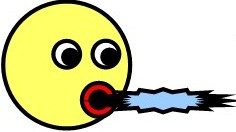On Friday, I was talking with someone at work about beer. She mentioned that her beer of choice is Bud Lite. I told her that when I drink American beer, it's usually Samuel Adams. After work, I went shopping and stopped off at the beer aisle.
Now, unless you live in a "dry" county, you can probably buy beer and wine at your local grocery store. When you walk along the beer aisle, you can see Darwin's Theory of Evolution in action. It's the survival of the fittest, and in this case, "fittest" is defined as what the customer wants to buy. The prime shelf space at eye level will be devoted to the best selling brands.
The biggest brewing corporation in America is Anheuser-Busch, which has a market share of about 50% between its various Budweiser and Michelob brands, followed by Miller and Coors. These are the mass-produced beers, readily available from sea to shining sea. There are also regional brands like Schaefer in New England, Iron City in Pittsburgh, and Olympia and Rainier in western Washington. (When I was stationed at Fort Lewis, Washington in 1984, we called Rainier Beer "Vitamin R.") And over the past couple of decades, smaller craft micro-breweries have gained in popularity among knowledgeable beer drinkers.
Just as dinosaurs suffered a catastrophe that wiped them out when the asteroid struck 65 million years ago, so also did American brewers suffer a catastrophe when Prohibition forced them to make different products (like "near-bear") from 1920-33. However, in this case, the catastrophe didn't kill off the largest brewers a la the dinosaurs. Instead, when Prohibition ended, the large brewers were in position to go right back into production, while many of the smaller breweries had been forced out of business. It took many years for them to make a comeback.
So what does all of this have to do with your local store's beer aisle? Well, the hallmark of the Theory of Evolution is that there are various ecological niches, and that if one of them is not currently filled, some organism will move into it and alter itself to fit the niche through speciation. The beer aisle also has ecological niches, or perhaps customer niches might be a better term.
For the past couple of decades, companies have put out an increasing numbers of varieties of their products, in order to reach potential customers who aren't interested in their original products. Just as Coca-Cola and Pepsi have put out many different variations on their core product (soft drinks), the beer companies have put out different variations such as light beer, alcohol-free beer, flavored malt liquors such as Mike's Hard Lemonade or the various flavored Bacardi drinks, etc. If the customers like the new varieties, they'll buy them and increase the company's market share. If they don't, they won't and the product will go the way of the mammoth in the tar pit. Survival of the fittest, baby.
One of the new varieties I spotted on Friday was Michelob Ultra with Cactus and Lime, with a picture of a prickly pear cactus on the label. Somehow, I doubt that this will ever be more than a niche product. I was curious about what it might taste like, but not six-pack curious, if you know what I mean. Nothing is worse than buying a six-pack of an unknown beer and finding that it is undrinkable. However, this might be popular among Hispanic beer drinkers. You never know. The only way to find out will be to check back in a year and see if the Cactus and Lime variety is still around. I'm sure that the Anheuser-Busch people did a lot of taste-testing prior to rolling out the product, so it must have done well enough with focus groups for them to green-light it. As with everything involved in the Darwinian struggle, only time will tell.

